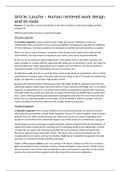Samenvatting
Samenvatting Artikelen - Organisatieontwerp
Samenvattingen van artikelen voor het vak organisatieontwerp (jaar 3 Bedrijfskunde): - Human centered work design and its roots - Lean thinking: what it is and what it is'nt - Lowlands Sociotechnical Design Theory and Lean Production - Organizing Innovation (Lekkerkerk) - Buurtzorg Nederland
[Meer zien]














